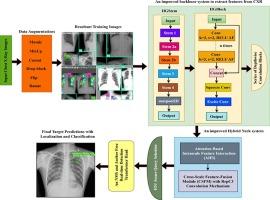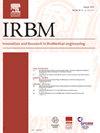基于变压器的RT-DETR框架用于胸部x射线疾病的准确检测
IF 4.2
4区 医学
Q1 ENGINEERING, BIOMEDICAL
引用次数: 0
摘要
目的胸部x线(CXR)分析是早期发现疾病、及时诊断和治疗的重要工具。然而,由于图像对比度低、解剖结构重叠和成像条件的变化,实现准确的CXR疾病检测仍然具有挑战性。本研究旨在利用RT-DETR模型开发一个强大而有效的疾病检测框架,以解决这些限制并提高诊断准确性。材料和方法提出的框架将基于变压器的组件集成到RT-DETR体系结构中,以增强特征表示。主干采用HGBlock和HGStem模块,通过分层梯度流捕获多尺度空间表示。在颈部网络中,注意强化特征交互(AIFI)模块和重参数化有效路径聚合(REpc3)模块改进了特征融合,增强了上下文理解。检测头采用RT-DETR解码器和高效的基于查询的机制,提高定位和分类精度。采用Wilcoxon检验、配对t检验和Kruskal-Wallis检验进行统计验证,以确保绩效结果的可靠性。结果提出的RT-DETR框架的准确率达到55.7%,比YOLOv7x的47.7%高出8%。召回率相当,我们的型号达到43.0%,而YOLOv7x为43.1%。重要的是,我们模型的平均平均精度(mAP)达到45.3%,比YOLOv7x的41.6%提高了3.7%。这些结果证实了该模型的优越性能及其统计显著性,并得到了应用试验的验证。结论与现有模型相比,基于rt - der的疾病检测框架在CXR分析中具有更高的准确性和鲁棒性。它集成了先进的基于变压器的模块,提高了特征表示和检测精度。结果突出了它作为一种可靠和有效的胸部x线疾病自动诊断工具的潜力,在现实世界的临床环境中具有很强的适用性。本文章由计算机程序翻译,如有差异,请以英文原文为准。

Transformer-Based RT-DETR Framework for Accurate Chest X-Ray Disease Detection
Objectives
Chest X-ray (CXR) analysis is a vital tool for early disease detection, enabling timely diagnosis and treatment. However, achieving accurate CXR disease detection remains challenging due to low image contrast, overlapping anatomical structures, and variations in imaging conditions. This study aims to develop a robust and efficient disease detection framework using the RT-DETR model to address these limitations and improve diagnostic accuracy.
Material and Methods
The proposed framework integrates transformer-based components within the RT-DETR architecture for enhanced feature representation. The backbone incorporates HGBlock and HGStem modules to capture multi-scale spatial representations through hierarchical gradient flow. In the neck network, the Attention-Intensified Feature Interaction (AIFI) module and the Reparameterized Efficient Path Aggregation (REpc3) module refine feature fusion and strengthen contextual understanding. The detection head employs the RT-DETR decoder with an efficient query-based mechanism to improve localization and classification precision. Statistical validation was conducted using the Wilcoxon Test, Paired T-Test, and Kruskal-Wallis Test to ensure the reliability of performance outcomes.
Results
The proposed RT-DETR framework achieved a precision of 55.7%, outperforming YOLOv7x's 47.7% by 8%. The recall was comparable, with our model achieving 43.0% versus YOLOv7x's 43.1%. Importantly, the mean Average Precision (mAP) of our model reached 45.3%, representing a 3.7% improvement over YOLOv7x's 41.6%. These results confirm the model's superior performance and its statistical significance as validated by the applied tests.
Conclusion
The RT-DETR-based disease detection framework demonstrates improved accuracy and robustness in CXR analysis compared to state-of-the-art models. Its integration of advanced transformer-based modules enhances feature representation and detection precision. The results highlight its potential as a reliable and efficient tool for automated chest X-ray disease diagnosis, offering strong applicability in real-world clinical settings.
求助全文
通过发布文献求助,成功后即可免费获取论文全文。
去求助
来源期刊

Irbm
ENGINEERING, BIOMEDICAL-
CiteScore
10.30
自引率
4.20%
发文量
81
审稿时长
57 days
期刊介绍:
IRBM is the journal of the AGBM (Alliance for engineering in Biology an Medicine / Alliance pour le génie biologique et médical) and the SFGBM (BioMedical Engineering French Society / Société française de génie biologique médical) and the AFIB (French Association of Biomedical Engineers / Association française des ingénieurs biomédicaux).
As a vehicle of information and knowledge in the field of biomedical technologies, IRBM is devoted to fundamental as well as clinical research. Biomedical engineering and use of new technologies are the cornerstones of IRBM, providing authors and users with the latest information. Its six issues per year propose reviews (state-of-the-art and current knowledge), original articles directed at fundamental research and articles focusing on biomedical engineering. All articles are submitted to peer reviewers acting as guarantors for IRBM''s scientific and medical content. The field covered by IRBM includes all the discipline of Biomedical engineering. Thereby, the type of papers published include those that cover the technological and methodological development in:
-Physiological and Biological Signal processing (EEG, MEG, ECG…)-
Medical Image processing-
Biomechanics-
Biomaterials-
Medical Physics-
Biophysics-
Physiological and Biological Sensors-
Information technologies in healthcare-
Disability research-
Computational physiology-
…
 求助内容:
求助内容: 应助结果提醒方式:
应助结果提醒方式:


